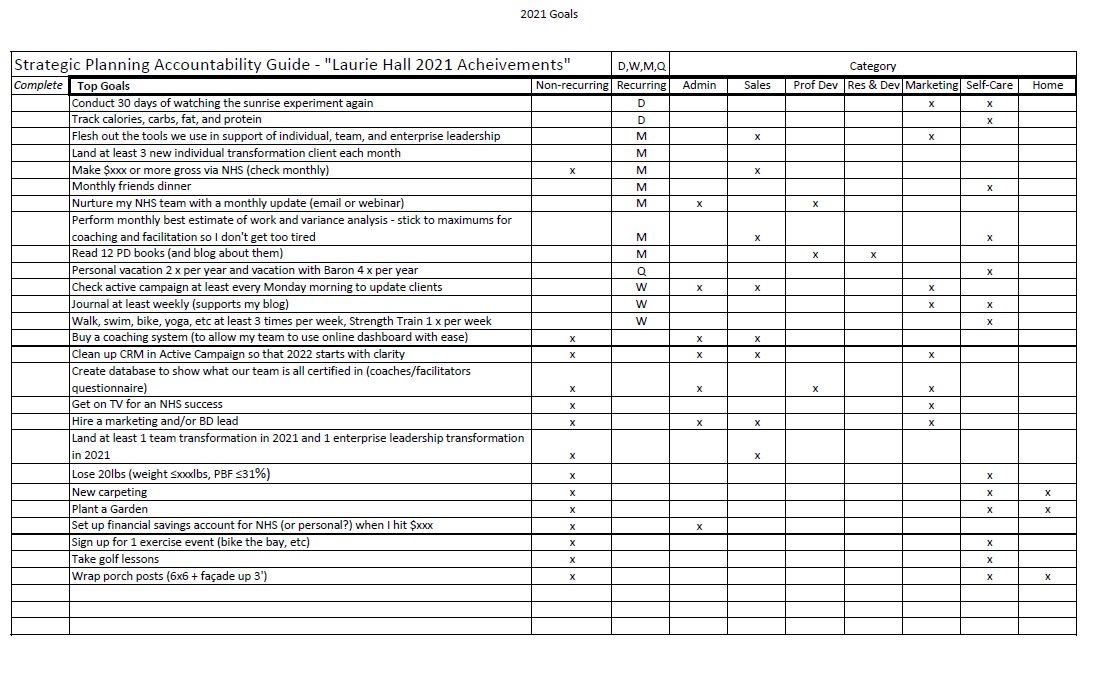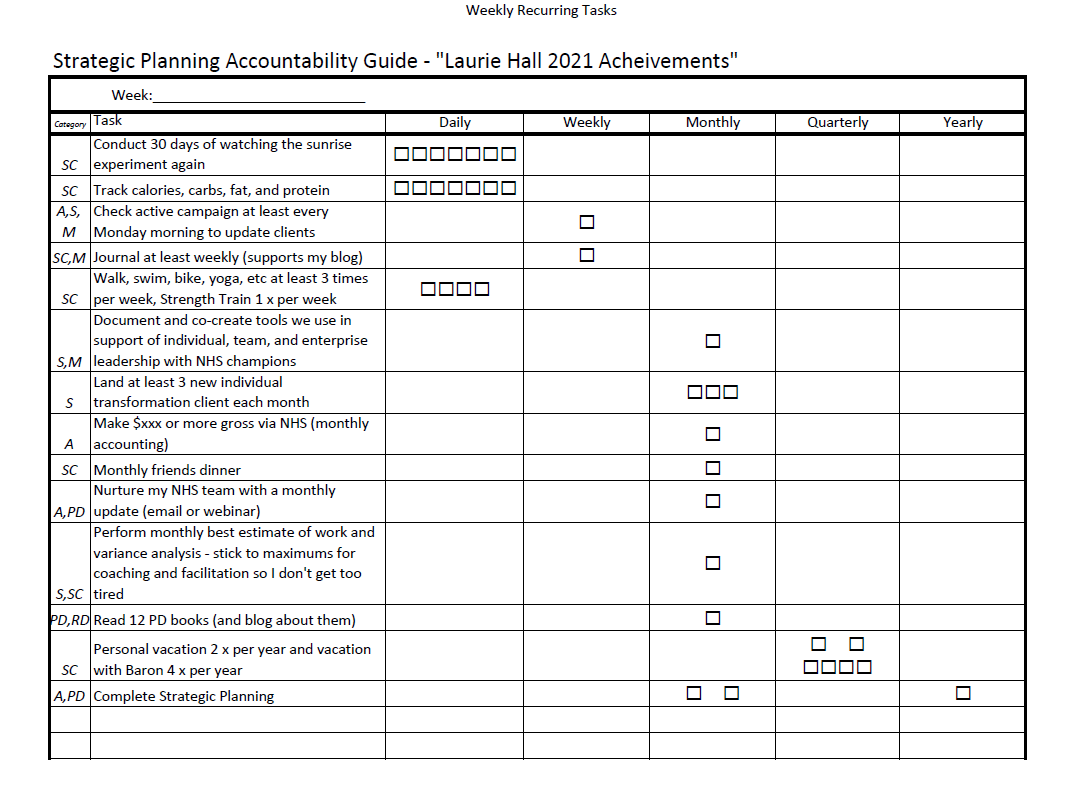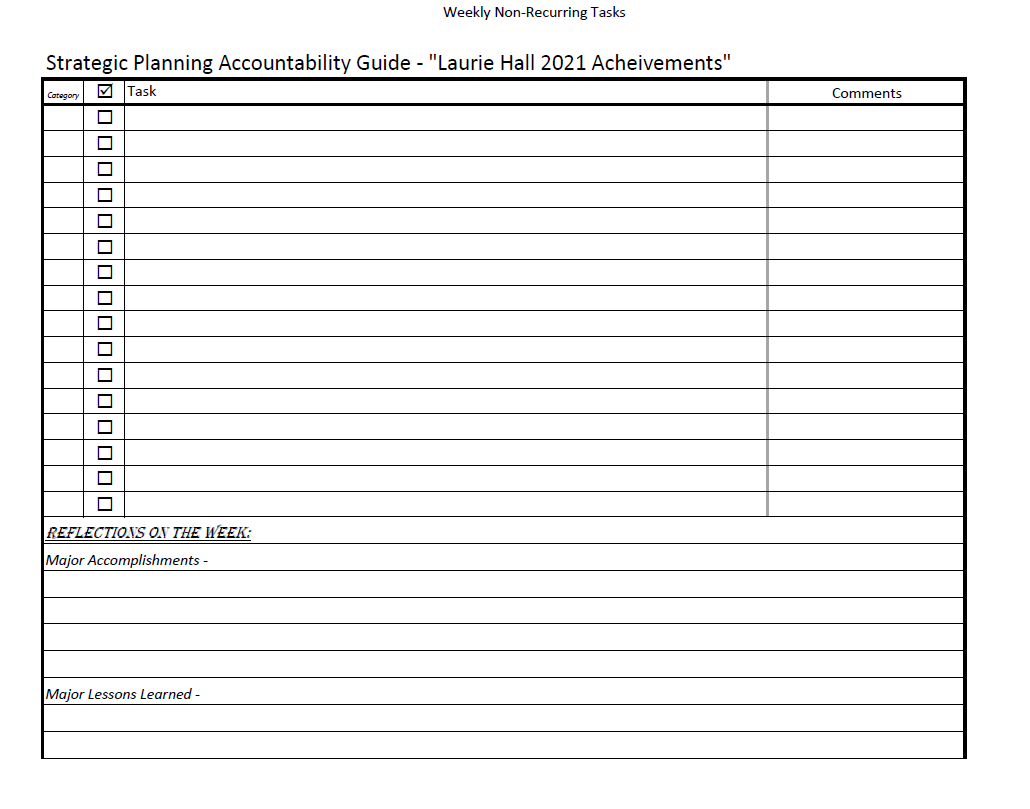Week 4: REFOCUS
Congratulations on spending so much time attracting success in the year ahead!
In week 1, you REFLECTED by “Looking Back Before you Looked Ahead”.
In week 2, you RESONATED on how the things you reflected on in the previous year felt by “Analyzing them with a Fine-Tooth Comb”. The way you answered those questions helped you to appreciate exactly where you are now, and what you want more of going forward.
In week 3, you used all that information to determine your “Refreshed Goals” by RESOLVING to use how things resonate for you like a compass. We may have to unlearn some of our adult habits to get back to checking in with ourselves and adjusting our goals based on how they make us feel.
This week, we’ll be using a simple, easy, fun tool to help you REFOCUS your efforts and measure progress along the way. If you already have that sinking feeling, perhaps thinking “OK, this is when strategic planning isn’t fun anymore,” let that go! Our mindset regarding measuring might need a reboot.
I recently had a client share a horror story of how her new boss wanted to know what she was doing in her job every day. With trust, she created a list of the job description areas from multiple jobs she was performing and added detail to how they integrated. Upon presenting it to her new boss, she was told “No, this isn’t what I meant. I mean, what is it you actually DO every day.” If you are already feeling your gut starting to tighten and twist, you realize why our mindset around measuring what we’re doing needs a reboot.
Innocently, but now a little more cautiously, she created a different way to describe what she was doing, how it impacted others, about how much time each task took, and shared this with her boss. Again, she was met with contraction. “No, this isn’t what I was looking for,” her boss said, with little additional information on exactly what she was looking for. As you’re probably picking up, the client is beginning to wonder if she is about to lose her job at this point and if her new boss is just trying to shore up who can do what she’s been doing.
That’s a horror story, but unfortunately, it may be relatable. We’ve all had people measure our progress in a way that feels punitive versus helpful. At what point have we started to measure our own progress in a way that is self-deprecating versus helpful? The original Chief Clinical Officer of Dr. Brené Brown’s research and education group originally said, “Shame often starts out as a two-person conversation but quickly turns into a one-person conversation in our lives.” We try to beat vulnerability to the punch by being so hard on ourselves that no one else will find anything to complain about. Does that resonate?
We need to rethink our mindset regarding measuring our progress with the following accountability tool. It not only makes it easy and fun, but it will also allow us to track reflections, resonations, and resolutions throughout the coming year to navigate change with resilience.
“Don’t measure busywork. Don’t measure activity. Measure accomplishment. It doesn’t matter what people do as much as it matters what they get done.”
— Larry Winget
Creating Your Accountability Guide Instructions:
You may have had a chance to complete the get-ahead (Step 5 from last week) where you came up with different categories of areas of your career, business, and life to align with what matters most for you right now. This helps us ensure we have balanced goals in all areas. Here are three examples. Use these to catalyze the creation of your own categories that make sense for you and what’s happening right now.
Business Owner Example:
- Administrative (Taxes, Accounting, Legal, Emails, Scheduling, IT, etc.)
- Sales (CRM, Sales Process and Metrics, Sales Calls/emails, Customer Satisfaction, Client Relations, etc.)
- Marketing (Campaigns, Website, Brand, Networking, etc.)
- Professional Development (Certifications, Continuing Education, Reading, Learning Management System for you and your team, etc.)
- Content or Intellectual Property (Internal Processes, Presentations, Research, Material, Client Forms, ROI/KPI calculators, etc.)
- Self-Care (Rest, Vacations, Retreats, Work-Life Balance, Reflection time, etc.)
More General Categories Example:
- Relationships (Friends, Family, Coworkers, Direct Reports, Leadership, Trust, etc.)
- Career (Job, Opportunities, Strategic Planning, etc.)
- Home (Current, Future, Updates, Remodels, Day-to-day, Play, Pets, etc.)
- Finances (Income, Expenses, Savings, Budgeting, Retirement, Estate Planning, Taxes, etc.)
- Health (Eating, Exercise, Sleeping, Emotional well-being, Vacations, Experiences, Energy Management, etc.)
- Faith (Believing in something, Religion, Journaling, Reflecting, Meditating, etc.)
Step 2: Assign Goals to Categories
Take all the goals from last week’s “Refreshed Goals” assignment and mark which category (or categories) each of your goals fits in to. I like to use a spreadsheet for this activity. Use the format that works best for you.
Step 3: Resonate on your Categorized Goals
Regardless of how you have chosen to categorize your career, business, and life, this helps us see where we are most focused on our goals. It does not have to be balanced, but let the ratios resonate with you to see if it feels right. Is there anything missing?
Step 4: Recurring or Non-recurring Goals
Now consider for each goal, “is this something that is recurring at a certain cadence throughout the year, or does it only happen once (or occasionally)?” For example, if a goal is to “Learn how to play golf”, that’s non-recurring. If a goal is, “Sell at least 3 new Executive Coaching Clients this month”, that is recurring on a monthly basis. For goals that are recurring, consider if they are recurring on a Daily (D), Weekly (W), Monthly (M), Quarterly (Q), or Annual (A) basis. Add notes for each goal to show this information.
Once you complete that, here is an example of what your goals list might look like after you complete this part.
 Step 5: Create Recurring Goals Checklist
Step 5: Create Recurring Goals Checklist
Set up your weekly measurements to assess your accomplishments, reflections, and lessons learned. This makes a world of difference. After identifying what is a recurring or non-recurring task, create an accountability guide with checkboxes to denote when something is complete. I print a new sheet of paper (yup, an actual piece of paper I can touch and feel!) each week to physically check off those boxes. I don’t know what it is about checking a box that feels so amazing. Try it yourself! Here is an example of what that looks like. I used Excel to create this template. Reach out to get our template .xls, but honor the method or program that works best for you in all cases. And, add recurring goals as necessary that help support your vision.
 Step 6: Your Accountability Guide
Step 6: Your Accountability Guide
Finally, add in your non-recurring goals. How do we account for that? Think of this like your To-Do list. Create a blank template for all the non-recurring tasks that come up each week. You may already be listing things you want to do each week (I typically do this on Monday mornings). You might want to add small tasks to this each week and denote which category even small tasks fit into. It is a conscious accounting and calibration of how we are focusing our energy.
Use the space at the bottom of the non-recurring tasks list to answer these two questions. I typically do this at the start of the next week when I’ve had time to put work down over the weekend and REFOCUS on the bigger picture. By Monday morning, I can look back on last week and appreciate how the tasks I completed tie into my larger goals.
- Major Accomplishments
- Major Lessons Learned
This creates space to reflect and resonate each week on how things are going to resolve (and adjust) our goals in real-time. Here’s an example.

And…THAT is how we put the FUN back in strategic planning! We hope you have enjoyed this 4-part series based on the New Horizon Strategies Transition to Transformation model and have had multiple breakthroughs along the way. We would love to hear how things worked for you during this planning cycle, how your goals and experiences unfold this year, and at the end of the year how these planning and accountability efforts made a difference.
Please schedule a time to check in with us whenever you are ready.
Enjoy all your Achievements!

